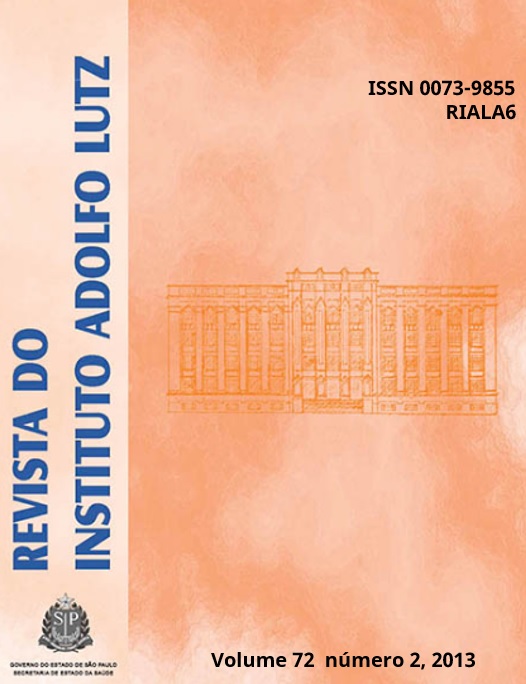Resumen
O desafio na produção de materiais de referência (MR) destinados a ensaios microbiológicos é a instabilidade natural dos micro-organismos. A liofilização é indicada para criopreservação de culturas bacterianas quando o número de células deve ser resguardado. Agentes protetores podem ser adicionados antes do congelamento para aumentar a estabilidade do material. Neste trabalho foram avaliados os
crioprotetores na produção de MR liofilizados a serem utilizados em ensaio de proficiência para contagem
de coliformes. Foram produzidos quatro lotes utilizando-se iferentes crioprotetores: solução de leite desnatado a 10% (EC1), a mesma solução contendo glicerol (EC2), sacarose (EC3) e trealose (EC4). Uma cepa de Escherichia coli foi empregada no preparo dos materiais. A homogeneidade foi avaliada conforme o Protocolo Internacional Harmonizado. A estabilidade foi estudada durante quatro meses à ≤ -70 ºC (longa duração) e às temperaturas de -20 ºC, 4 ºC, 25 ºC e 35 ºC durante cinco dias (curta duração), segundo a ISO/GUIDE 35. Apenas EC1 foi considerado não homogêneo. Os lotes permaneceram estáveis à ≤ -70 ºC durante quatro meses. EC2 apresentou resultados insatisfatórios na estabilidade de curta duração. EC3 e EC4 foram homogêneos e estáveis nas temperaturas estudadas. A sacarose e a trealose foram consideradas crioprotetores adequados para o preparo do MR em questão.
Citas
1. Associação Brasileira de Normas Técnicas (ABNT). NBR ISO/IEC 17025 – Requisitos gerais para a competência de laboratórios de ensaio e calibração. Rio de Janeiro (RJ), 2005. 31 p.
2. Roberts D. Proficiency testing in the food microbiology laboratory. Arch Hig Rada Toksikol J. 1999;50(1):55-65.
3. Thompson M, Ellison SLR, Wood R. International harmonized protocol for proficiency testing of (chemical) analytical chemistry laboratories. Pure Appl Chem. 2006;78(1):145-96.
4. Philipp WJ, Iwaarden PV, Schimmel H, Meeus N, Kollmorgen N. Development of reference materials for microbiological analysis. Accred Qual Assuranc. 2007;12(3-4):134-8.
5. Rosas CO, Brandao MLL, Bricio SML, Medeiros VM, Bernardo SPC, De La Cruz MHC, et al. Desenvolvimento de Material de Referência em Microbiologia de Alimentos. Rev Inst. Adolfo Lutz. 2010;69(1):15-22.
6. Brandão MLL, Rosas CO, Bricio SML, Costa JCB, Medeiros VM, Warnken MB. Produção de materiais de referência para avaliação de métodos microbiológicos em alimentos: estafilococos coagulase positiva e Listeria spp. em leite em pó. Rev Analytica. 2013;63(Fevereiro/Março):60-71.
7. Hubálek Z. Protectants used in the cryopreservation of microorganisms. Cryobiol. 2003;46(3):205-29.
8. Morgan CA, Herman N, White PA, Vesey G. Preservation of micro-organisms by drying; A review. J Microbiol Meth. 2006;66(2):183-93.
9. Carvalho AS, Silva J, Ho P, Teixeira P, Malcata FX, Gibbs P. Relevant factors for the preparation of freeze-dried lactic acid bacteria. Int Dairy J. 2004;14(10):835-47.
10. Oliver AE, Hincha DK, Crowe JH. Looking beyond sugars: the role of amphiphilic solutes in preventing adventitious reactions in anhydrobiotes at low water contents. Comp Biochem Physiol Part A. 2002;131(3):515-25.
11. Leslie SB, Israeli E, Lighthart B, Crowe JH, Crowe LM. Trehalose and sucrose protect both membranes and proteins in intact bacteria during drying. Appl Environ Microbiol. 1995;61(10):3592-7.
12. Wessman P, Mahlin D, Akhtar S, Rubino S, Leifer K, Kessler V, et al. Impact of matrix properties on the survival of freeze-dried bacteria. J Sci Food Agric. 2011;91(14):2518-28.
13. Brasil. Ministério da Saúde. Resolução RDC nº 12, de 2 de janeiro de 2001. Aprova o Regulamento Técnico sobre Padrões Microbiológicos para Alimentos. Diário Oficial [da] República Federativa do Brasil. Brasília, DF, 10 jan. 2001. Seção 1, nº7-E. p. 45-53.
14. Jay JM. Indicadores Microbiológicos de Qualidade e Segurança dos Alimentos. In: Jay JM, editor. Microbiologia de alimentos Sexta Edição. Porto Alegre: Artemd, 2005. p. 413-31.
15. Schulten SM, In’t Veld PH, Ghameshlou Z, Schimmel H, Linsinger T. The Certification of the Number of Colony Forming Particles of Salmonella typhimurium and Number Fraction of Negative Capsules from Artificially Contaminated Milk Power: CRM 507R. Belgium: European Commission, 2001. 74p. ISBN 92-828-991-8. [acesso 29 Nov 2012]. Disponível em: [http://publications.jrc.ec.europa.eu/repository/handle/111111111/4261].
16. International Organization for Standardization – ISO. ISO/GUIDE 35 – Reference materials – General and statistical principles for certification. Geneva; 2006.
17. Lamberty A, Schimmel H, Pauwels J. The study of the stability of reference materials by isochronous measurements. Fresenius J Anal Chem. 1998;360(3-4):359-61.
18. Brandão MLL, Costa JCB, Farias FM, Rosas CO, Bricio SML, Nascimento JS, et al. Desenvolvimento de material de referência para microbiologia de alimentos contendo estafilococos coagulase positiva em matriz queijo. Braz J Food Technol. 2013;16(1):73-9.
19. Vieira LR, Rosas CO, Brandão MLL, Medeiros VM, Costa JCB, Bricio SML. Desenvolvimento de Metodologia para a Produção de Material de Referência em Matriz de Carne Bovina para Detecção de Salmonella spp. XVII Encontro Nacional de Analistas de Alimentos e III Congresso Latino Americano de Analistas de Alimentos; Cuiabá – Mato Grosso: Anais do 17º ENAAL e 3º Congresso Latino Americano de Analistas de Alimentos 2011.
20. Welsh DT, Herbert RA. Osmotically Induced Intracellular Trehalose, but not Glycine Betaine Accumulation Promotes Desiccation Tolerance in Escherichia coli. FEMS Microbiol Letters. 1999;174:57-63.

Esta obra está bajo una licencia internacional Creative Commons Atribución 4.0.
Derechos de autor 2012 Revista del Instituto Adolfo Lutz
